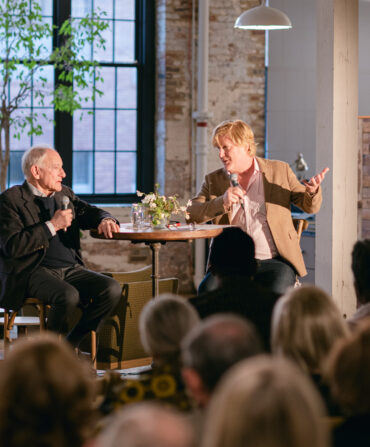Arts & Culture
Queen Elizabeth II’s Special Connections to the South
On her many visits to the region, the steel magnolia—or rather, rose—of Britain enjoyed college football, Florida Keys boat rides, and particularly, her beloved Kentucky horses

Photo: David Perry/Lexington Herald-Leader/Associated Press
Queen Elizabeth II on a visit to Lane’s End Farm in Kentucky in 1991. Accompanying the queen was Will Farish (left, behind horse), Lord Porchester, and Sarah Farish.
Among the many bright assets Elizabeth Alexandra Mary Windsor, later simply Elizabeth II, bore so lightly and yet firmly over her seventy-year reign was a deep love of the country life: horses, dogs, bird shoots, the jolly stirrup cup as the fox hounds were gathered in the morning fog before the hunt set off, sherry and sandwiches out of hampers on tailgates of the shooting brakes after the hunters and their loaders had clambered out of their blinds. By 1815 these sporting ways had been codified in Britain and its colonies and former colonies; the sporting vestments, tack rooms, stables, and gun closets were passed down through Victoria’s reign to Albert and Edward, Elizabeth’s father and uncle, in the 1920s.
The young Princess Elizabeth breathed it all in, the life planted her out of doors, and then, like that other gift she had—her monumental sense of duty—she bore its habits for the rest of her days. At twenty-five, when she was crowned, the glowing princess-turned-queen already had a racing stable. She kept it.

Photo: Associated Press
Elizabeth takes in the Maryland-North Carolina college football game in 1957 in College Park, along with Maryland Governor Theodore McKeldin.
Her experience formed a cultural kinship that drove Queen Elizabeth’s deep connection to the American South—the seaboard side of which, including Florida, and chunks of the upland South, including Virginia and Kentucky, had been British colonies whose people to this day remain passionate about country pursuits. In a larger context, it’s important to recall that the British royal family’s tourism is essentially a diplomatic maintenance of bonds between nations. Over the decades, Elizabeth was careful to practice that sort of transatlantic soft-power diplomacy in the South on various trips to America, touring such spots as Williamsburg and the Florida Keys, and taking in a Maryland–North Carolina football game in College Park, as pictured above.
But her Southern sojourns went far beyond that, becoming an integral part of the Queen’s own intensely personal venture to breed and race horses, which led her to the crucible of the finest Thoroughbreds in the world, the Kentucky Bluegrass. There, with characteristic, infinitely detailed care, she boarded quite a number of her stable’s mares in order to breed them to American bloodstock, whose provenance and talents she minutely researched. It brought her no end of joy and was a practice she kept up for decades, making lifelong friends in the doing. In the annals of Elizabeth’s epic globetrotting reign, the South stands out as the one great, private exception. She returned, and returned, and returned again, drinking deeply from the well.
A higher percentage of the racing in Britain is on turf, meaning on the grass, as opposed to dirt. The races trend longer, and more of them are steeplechases, than we see in America, all of which is to say, a lot of English breeders seek endurance, not speed. Queen Elizabeth felt she needed more speed in her stable, and the best place for that was Kentucky.
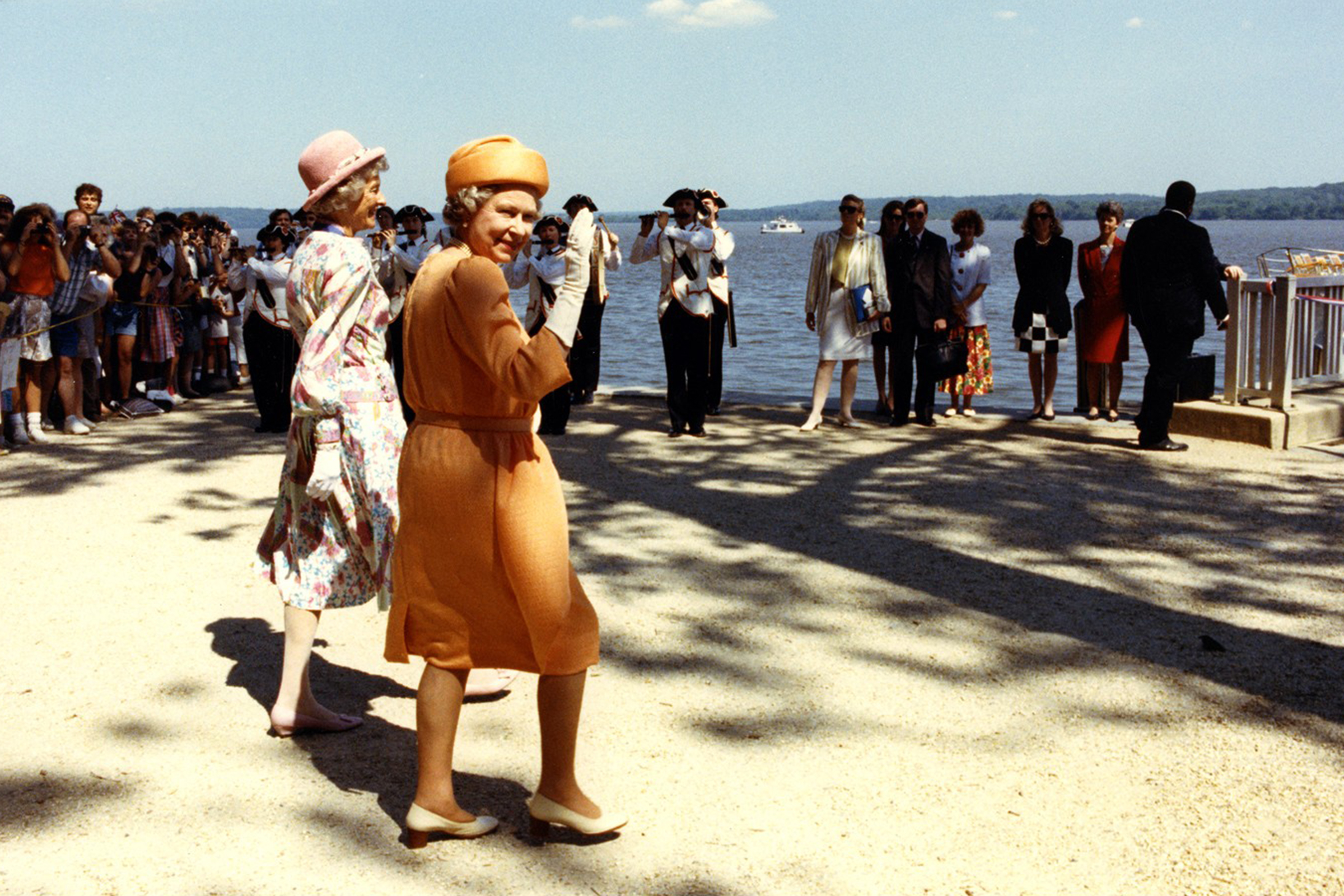
Photo: Mount Vernon
At the dedication of the Mount Vernon Wharf in Alexandria, Virginia, in 1991.
The first horse the Queen flew from England to Lexington, in 1984, was a mare named Christchurch, who was eventually bred to the champion Alydar. She got her first “American” foal in 1985. Her then racing manager, Lord Carnarvon, recommended the Queen seek out prominent Bluegrass breeder William Stamps Farish III, and his wife, Sarah, of Versailles, Kentucky. Like his grandfather, a chair of Standard Oil, Farish had had great success in business in Texas and was a long-standing Bush family friend and former adviser to George Herbert Walker Bush. Already in racing, Farish had moved from Texas to Kentucky with the notion of starting a new breeding operation in the late seventies.
By 1984, the Farish farm, the idyllic, three-thousand-acre Lane’s End, was still a comparatively new enterprise in the Bluegrass, but it was huge and state of the art, boasting by farm standards extremely luxurious separate barns for weanlings, yearlings, mares, and stallions. The custom-built fences that shape their pastures elliptically—meaning, with rounded corners to prevent the horses from gaining any purchase to injure themselves—remain a particular point of pride to their formidable architect and owner, who breezily asked this reporter on his last visit to Lane’s End, “Do you have any idea what it takes to lay in so much fence without any corners?”
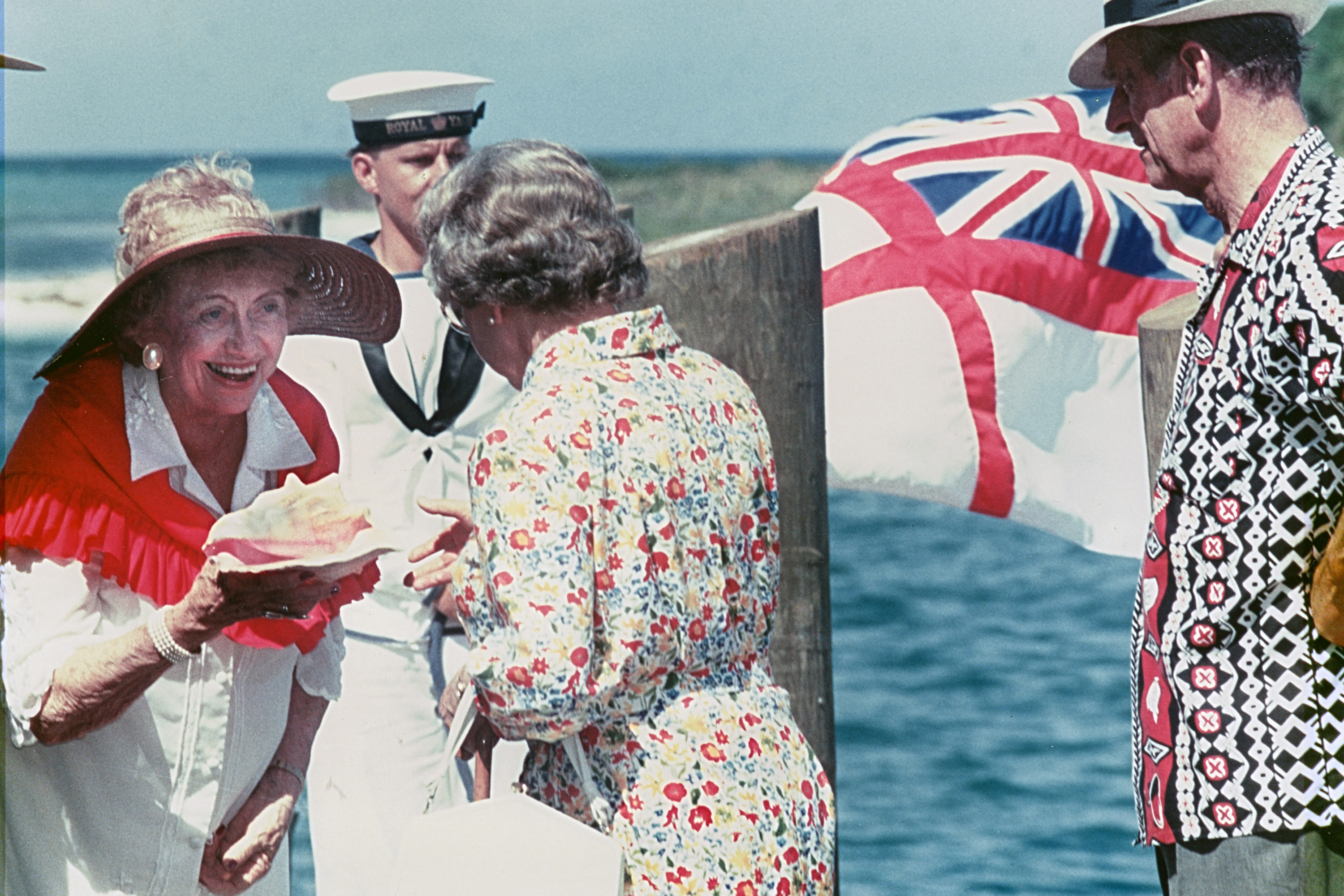
Photo: Andy Newman/Florida Keys News Bureau
Wilhelmina Harvey, a philanthropist and longtime public official in the Florida Keys, presents a conch shell to the queen during a 1991 visit to Dry Tortugas National Park.
Not surprisingly, in Farish’s first decade of operation, his foals won more than eighty stakes, an astonishing number even in Kentucky, and the farm inevitably came into the Queen’s gunsights.
Elizabeth was introduced to the Farishes through her friend Paul Mellon, the late Cambridge-educated, Virginia-based horse breeder and banking heir. Explaining the Farish connection to the still more than slightly mystified American press corps on the occasion of the Queen’s May 1989 visit to Lane’s End—at that point her third private “vacation” with the Farishes in Versailles—Lord Carnarvon said that the Queen’s stable (boasting then some twenty-two mares) was relatively modest by the late-twentieth-century standards of international racing. Not least because international racing was trending toward the American style of shorter flat races held on dirt. A mile-and-a-quarter, the length of the Kentucky Derby and a relatively long race in the States, is considered a short race in Britain.
“It’s hard work winning races when you’re up against people with five hundred mares,” Carnarvon said. “The effort is for speed, now that the international market has gone heavily into the mile-and-a-quarter. By coming to America, she’s getting the speed she couldn’t get in England. Mr. Mellon and I felt that the ideal place for her to come would be Mr. Farish’s, the stud farm here, being so well isolated from a security point of view. We got in touch with Mr. and Mrs. Farish, and they were thrilled at the idea. And it’s been a great success.”
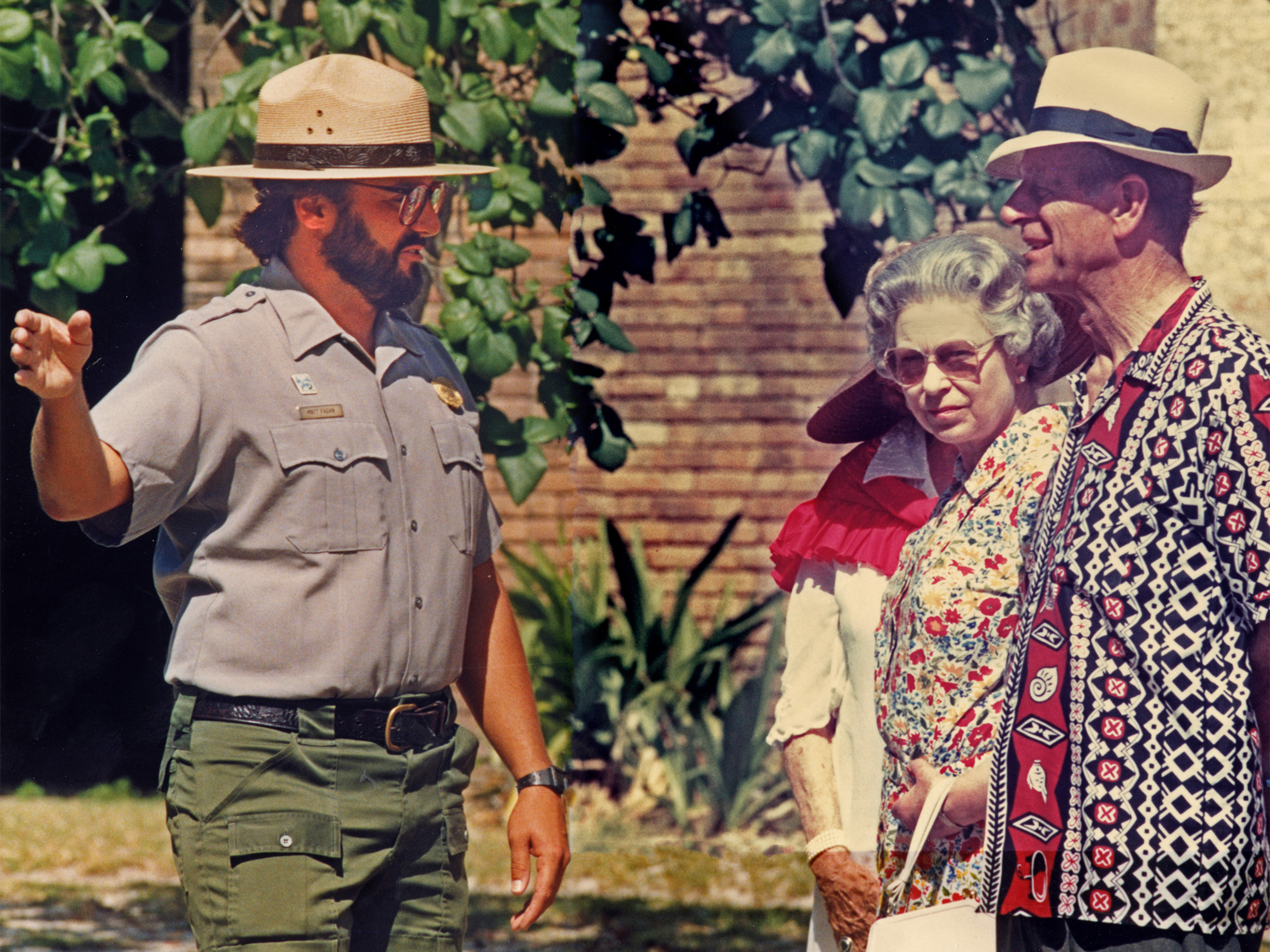
Photo: Andy Newman/Florida Keys News Bureau
National Park Service ranger Matt Fagan gives Elizabeth and her husband, Prince Philip, a tour of Fort Jefferson in Dry Tortugas National Park.
A British embassy spokesman, dutifully dispatched from Washington, D.C., to join the Queen’s burgeoning retinue of Secret Service and Royal Protection Force officers, emphasized the point. Aside from staying in her own castles, he said, she had not made so many private visits to any one location except, happily, to the Farishes, whose low-key hospitality especially impressed their guest. The Farishes treated the Queen in what the embassy officer called “the right way,” sans fuss. They put on small dinner gatherings with horse people, and often the Queen would have Farish at her side when she went on stallion searches to other farms.
For his part, the Queen’s eminently straight-spoken host—who would later serve President George W. Bush as America’s ambassador to the Court of St. James for three years, arguably one of the smarter diplomatic postings to Great Britain by any American administration—described the Queen after her May 1989 visit to the press as “…a fantastic horsewoman. She knows the sport, and she knows horses completely. We had meetings with leading trainers and veterinarians, and she talks their language.”
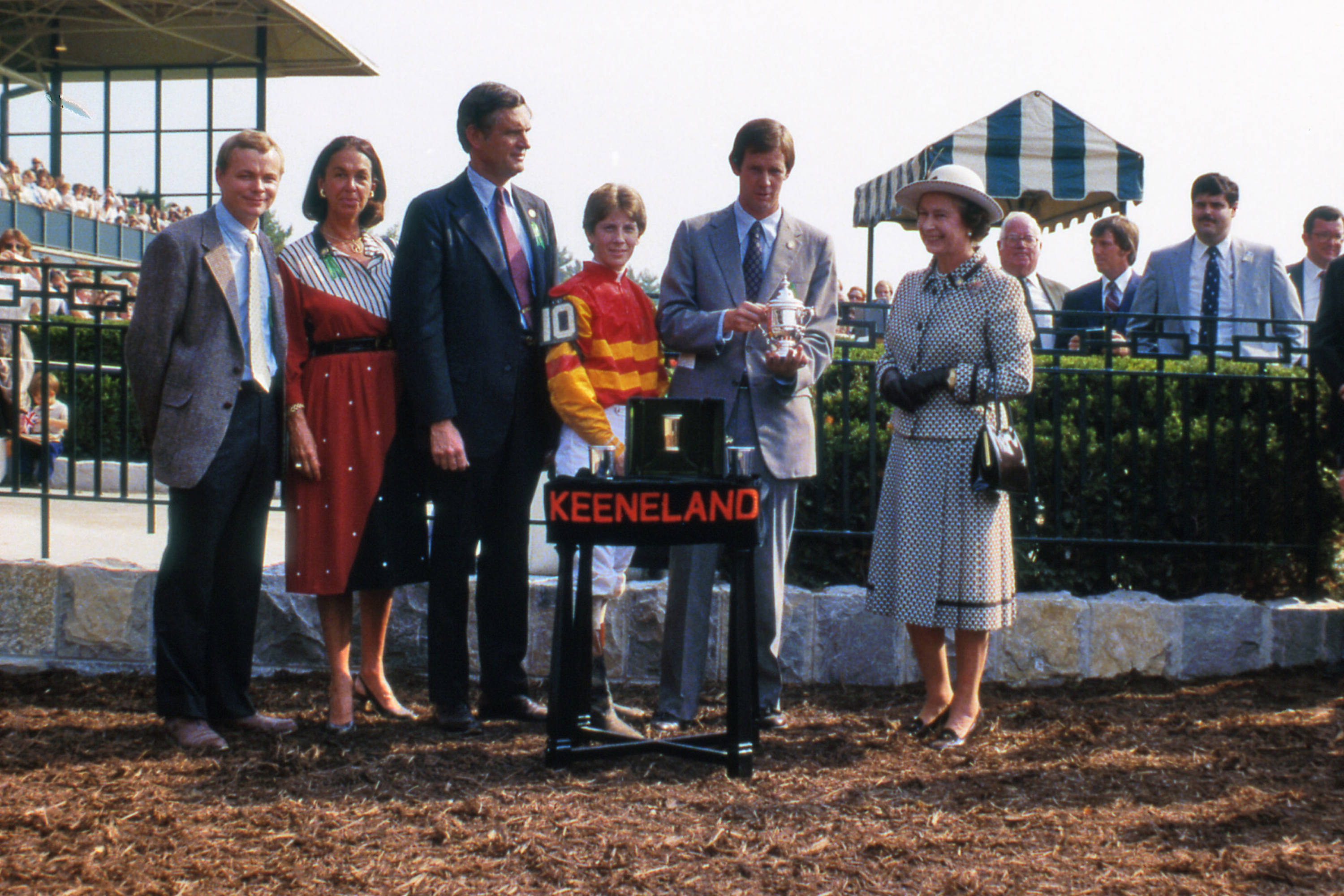
Photo: Keeneland Library
Elizabeth visits Keeneland in Lexington, Kentucky, in 1984 for the first Queen Elizabeth II Challenge Cup.
In all, Queen Elizabeth II graced Kentucky five times, including, on one trip, a visit to Keeneland for the inaugural running of the Queen Elizabeth II Challenge Cup, aptly, a race on turf with a tidy $500,000 purse. Keeneland still runs the race, which Lane’s End now sponsors. In Kentucky, she ventured outside the Bluegrass only once: In May 2007, with a dashing Prince Philip and Ambassador William Farish in tow, she made the trek from Lexington to Louisville to take in the Kentucky Derby. For the festivities and the obligatory balcony appearance—which was richly applauded as the crowd found her—she wore her de rigueur white gloves, a lime green suit, and a matching racing bonnet festooned with an outrageous pink bow.
Along the way, year by year, with the million details she made it her business to carry, she inevitably took on gravitas. By the first third of her reign—roughly at her Silver Jubilee in 1977, twenty-five years in—she had already outstripped many of the monarchs before her in longevity upon the throne. By 2012’s Diamond Jubilee—sixty years down, ten to go—she was rounding on her great-grandmother Victoria’s record, and, like her great-grandmother, the Queen had quietly become the rock of Europe. At her Platinum Jubilee a few short months ago, the larger world began to grasp the enormity of the epoch she bestrode, the one she had lived and has just now closed. She was every bit its measure.
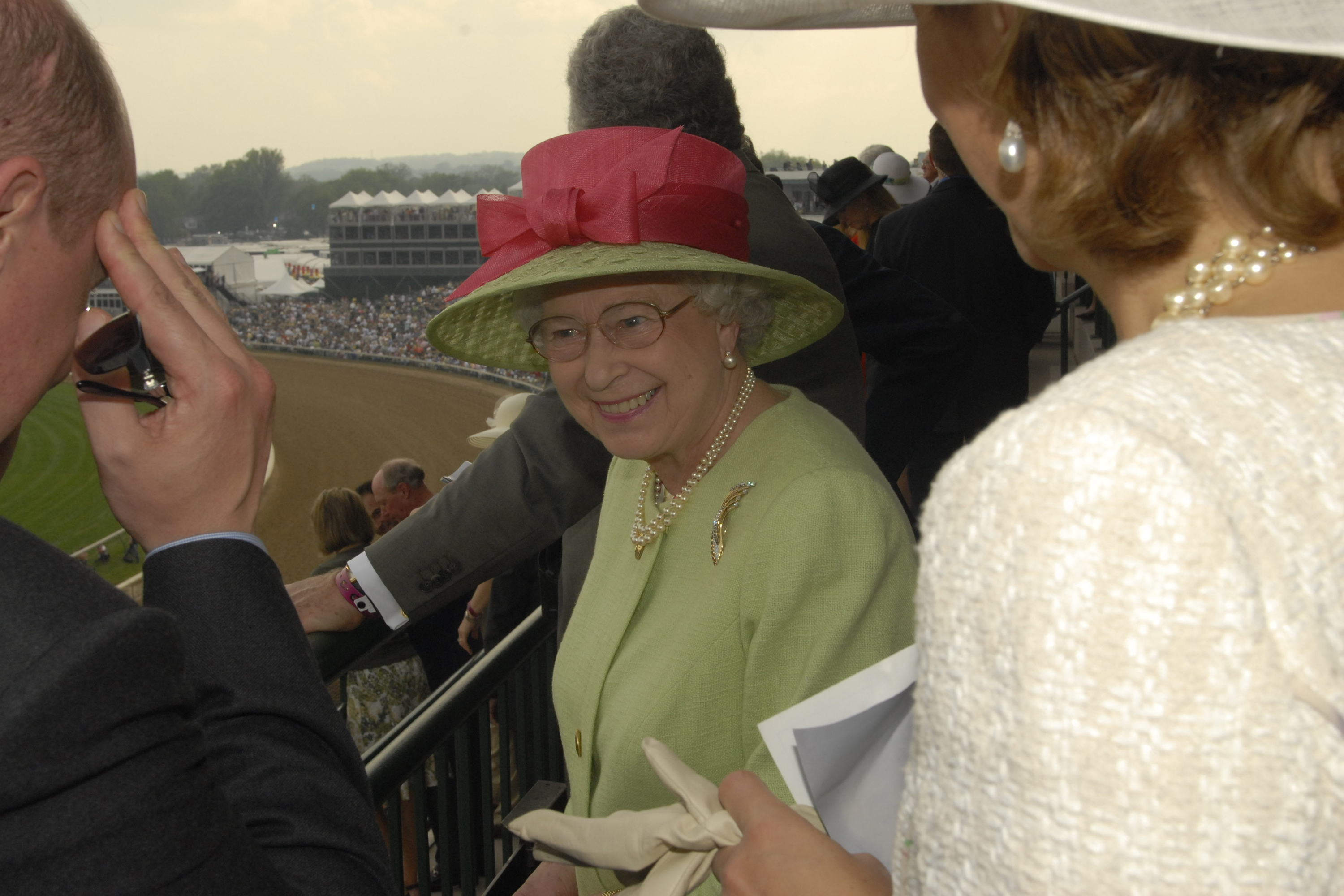
Photo: Churchill Downs Racetrack
Enjoying the 2007 Kentucky Derby at Churchill Downs.
In the grander arc of that world-beating reign, the longest of any British monarch, she bears another connection to the South. One part duty, three parts old-fashioned grit, this bond is made of more elusive human elements than the iron and brick in a Bluegrass breeding barn, but they’re no less strong. In what we could easily argue is the most unapologetically anglicized region of the United States, what Southern town, small or large, doesn’t have such a grande dame running things? They may not have the cut-glass accent, nor be attended by ladies-in-waiting, nor have a billion-dollar collection of tiaras handed down for five hundred years. But down to the sweater sets, sensible flat shoes, and an unending wellspring of steely enterprise to get everybody up off their asses and get it all done, they are of the exact muster of Elizabeth II.


